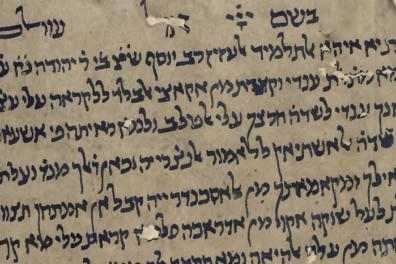Discovering the language
History of Judeo-Arabic
Judeo-Arabic, or the Arabic language of Jewish communities, is an ethnolinguistic group that has been attested in all Arab countries since the Middle Ages. It is a variant of the vernacular, attesting to the linguistic particularities common to Jewish languages. It does not, however, constitute a single common language, but rather dialectal usages as diverse as those that characterize the different Arab groups. It is found from Morocco to Iraq, via Libya and Yemen.
Its particularity lies in the use of numerous Hebrew terms mixed with an Arabic oral substratum. It also features a long series of proverbs and expressions specific to Jewish communities, and often a particular accent attesting to the various population movements relating to Mediterranean Jewish history.
As with other Jewish languages (Judeo-Spanish, Yiddish, Judeo-Persian, etc.), Judeo-Arabic is written in Hebrew characters. It is also a language of literature, poetry and religious essays, the idiom of the Jewish scholars of Andalusia and Iraq, as well as of the modest populations of the Jewish quarters (Mellah) of contemporary Maghreb.
In the 20th century in North Africa, the majority of speakers were bilingual Judeo-Arabic/French. Today, the various Arabic languages spoken by Jewish communities are on the verge of extinction. They are found among a handful of people in France (Paris, Marseille, Lyon, Montpellier, etc.), Israel (Ashdod, Netanya, Dimona, Beer-Sheva, etc.), Morocco (Casablanca, Marrakech, Fez, etc.), Tunisia (Tunis, Djerba) and Canada (Montreal).
Jewish-Arabic and France
When the French arrived, the Jewish populations of North Africa represented the largest local religious minority. In 1870, the Crémieux decree granted French nationality to over 35,000 "indigenous Israelites". Judeo-Arabic became the language of many French citizens. In 1962, the local Jewish community, then over 100,000 strong and French for more than 90 years, joined the metropolis.
Jews from Morocco and Tunisia would also emigrate in large numbers to France following the independence of these two countries. At the time, Judeo-Arabic was the family language of over 300,000 French people.
This language is one of the last testimonies to the cultural symbiosis and identity of the Jewish and Muslim populations of the Maghreb. In these times of identity tensions and conflicting memories, Judeo-Arabic languages represent a not inconsiderable bridge between communities, at a time when many strive to downplay differences and disagreements.
Studying Judeo-Arabic at Inalco
Judeo-Arabic is taught in a handful of Israeli and Moroccan universities. The teaching given at Inalco is unique in Europe, and in this sense, it is essential to preserve it as it represents the possible Judeo-Arab or even Judeo-Muslim cultural symbiosis.
This teaching comes in three levels and is available as an option both for students in the Hebraic and Jewish Studies department and for those in the Arab Studies department. It is a privileged meeting place, a bridge between communities with sometimes difficult relations
The teaching focuses on the Jewish dialects of North Africa. The aim is to provide students with a scientific understanding of the linguistic diversity that characterizes these dialects, so that they can go on to study Judeo-Arabic literature. In addition to the study of language and literature, through the analysis of texts, the teaching enables emphasis to be placed on various aspects of the civilization of the Jews of the Maghreb, more specifically at the historical, sociological and ethnological levels, as well as on Judeo-Muslim relations.
This teaching fits in perfectly with both Jewish and Arabic studies. For some, it is a family language, attesting to the Arabic culture of the Jewish communities of the Maghreb. For others, it bears witness to the richness and diversity of North African cultures.
(Report drawn up on 22-09-2013 by lecturer Mr. Jonas Sibony)
